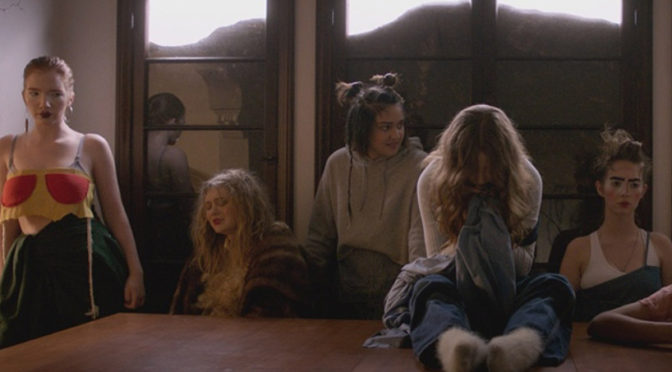Amanda Kramer’s LADYWORLD adopts a somewhat Suspirian lens to stand adolescent turmoil adjacent to a suggested end of days unravelling outside the walls of the ominous sanctuary sheltering a dysfunctional group of young women. While Kramer’s experimental premise sparks initial intrigue into this surreal dystopia, the artistic format fails to illustrate a vast enough kaleidoscope to develop a clear message, or a translatable insight into Kramer’s vision.
A natural disaster forces eight girls to take refuge in a mansion to hide from the chaos outside the walls. With phone batteries dying and supplies finite, the girls break into their most primitive selves; functioning through fear, desperation, paranoia and distrust.
There is an impressive dream-like quality within Kramer’s direction, which is established from nightmarish screams as the film opens, to the consistent wind-like wailing that serves as the film’s predominant soundtrack. But, the eerie qualities within the film’s composition become dulled with excessive repetition. While the abstract qualities do not completely succeed in execution, Kramer manages to personify the ambience of impending doom through the simplicity of the house’s pulsating walls, that cave further in with every twist of the camera. What, however, limits LADYWORLD as a vessel for cultural exploration is the hegemony of experimentalism and it’s precedence to the narrative: where Kramer’s avant-gardeness should have instilled a spectrum of existential questioning, it serves as an obstacle to a deeper debate, and isolates the audience from the conversation.
The atmosphere within LADYWORLD absorbs the brushstrokes of Argento and Aronofsky, through the creation of an unconscious cinema that submerges the spectator down into a realm of semiotics that resist definition; but the lack of poetical discourse renders a sense of incompletion in the imagery and dialogue. Perhaps the most significant scene to aid our understanding of LADYWORLD is Blake’s assertion that art must also encompass ugliness; “…beauty’s empty, it’s like, oppressive.” This scene begins to help us filter the chaos that resides through the style and plot of the film, and LADYWORLD can now be examined as a rejection of conventional cinematic institutions, and equally a rejection of the emptiness of femininity as a hypnotic tool within film, that serves to sell an idea of womanhood. Unfortunately, Kramer’s methodology drowns in ambiguity, and the products of her experiment becomes lost in the background.
The actors do well to add complexity and fragility to their unusual characters, but the theatricality of the clownery, and ritualistic dancing often seems misplaced, and something that would have more impact on stage than on screen. All the elements of Kramer’s process are emphatically engrossing and provocative, but added together they become more jarring than harmonious. The concept of LADYWORLD is holistically mesmerising, but it is something that would have translated much more smoothly within a short film, or theatrical production, rather than a feature.
Kramer’s direction is worthy of merit in LADYWORLD, but the eight heads of the female psyche never manages to formulate any resemblance of a person. Within LADYWORLD Kramer has succeeded in breaking through the walls of expressive cinema, nonconformist cinema, and in some respects feminist cinema; but the film has failed to fully break through the fourth wall.

